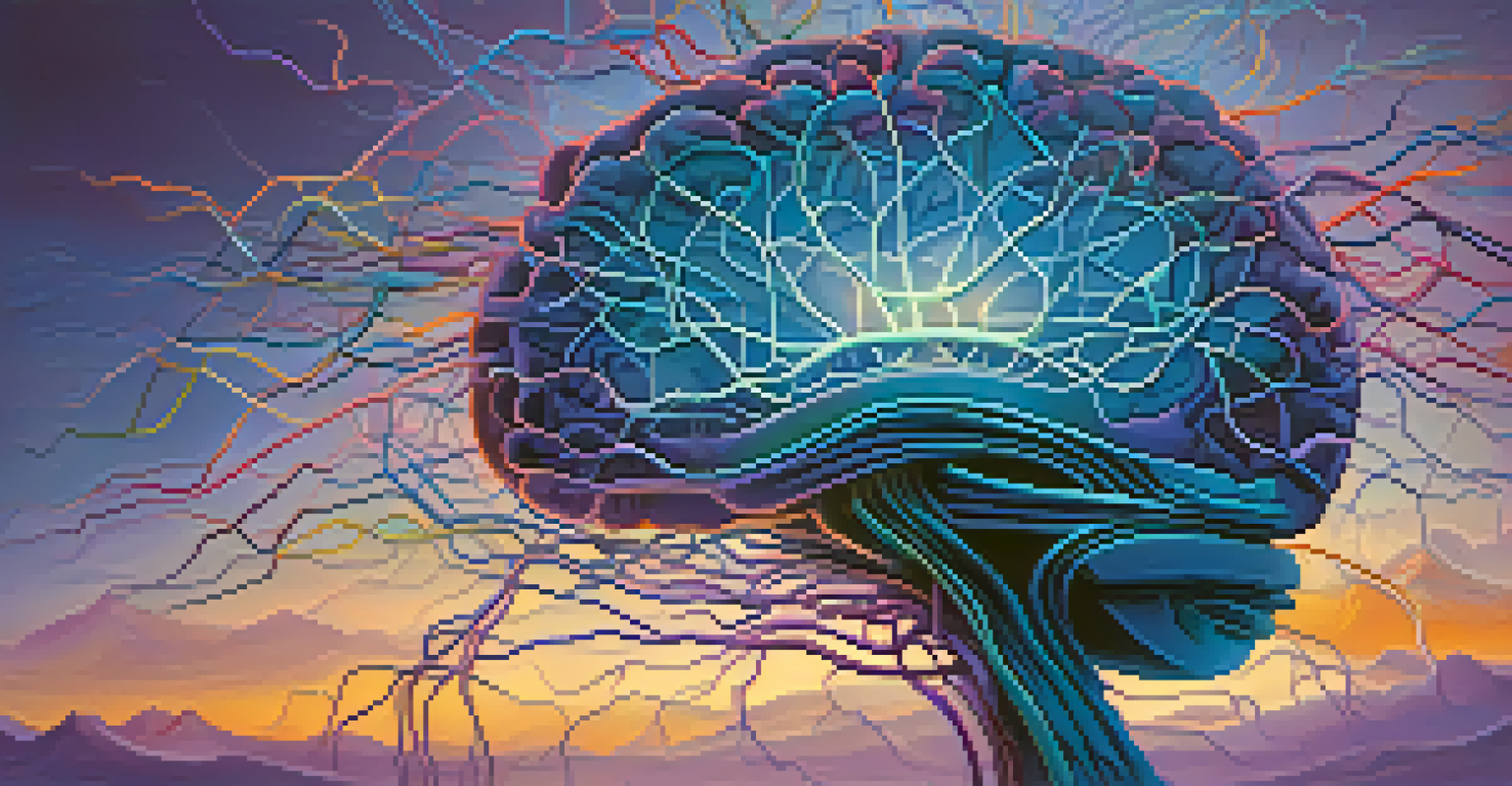Neuroplasticity and Addiction: Pathways to Healing Explained

Understanding Neuroplasticity: The Brain's Adaptability
Neuroplasticity is the brain's remarkable ability to reorganize itself by forming new neural connections. This adaptability allows our brains to adjust and respond to experiences, learning, and even recovery from injury. Think of it as a road map that can be rerouted when faced with obstacles. Just like how a traffic jam leads us to find alternative routes, our brain finds new paths to compensate for damage or loss.
The brain is a complex and dynamic organ that has the ability to adapt and change throughout our lives.
This phenomenon is particularly relevant in the context of addiction, where unhealthy patterns can become deeply ingrained. Over time, repeated substance use can alter brain structure and function, reinforcing pathways that lead to cravings and compulsive behaviors. However, the silver lining is that these pathways are not fixed; they can be reshaped through conscious effort and therapeutic interventions.
By understanding neuroplasticity, we unlock the potential for recovery. It highlights that change is possible, and individuals can learn to forge healthier habits, ultimately rewiring the brain to support a sober, fulfilling life. This hope is essential for those battling addiction, as it emphasizes that healing isn't just a dream—it can be a reality.
The Impact of Addiction on Brain Function
Addiction significantly alters brain function, affecting areas responsible for judgment, decision-making, and impulse control. When someone engages in substance abuse, the brain's reward system is hijacked, leading to feelings of pleasure that overwhelm natural rewards like food or social interactions. This shift can create a vicious cycle, where the brain craves the substance to replicate those feelings, often at the expense of everything else.

Furthermore, the changes in brain chemistry can lead to a decrease in the production of neurotransmitters, which are essential for mood regulation and overall mental health. For instance, dopamine, often termed the 'feel-good' neurotransmitter, becomes less responsive over time with continued substance use. As a result, individuals may find it harder to experience joy without the substance, deepening their reliance on it.
Neuroplasticity Enables Healing
The brain's ability to reorganize itself allows individuals to reshape unhealthy behaviors and foster recovery from addiction.
Recognizing the profound impact of addiction on brain function is crucial for recovery. It sheds light on why simply stopping substance use isn't enough; healing involves retraining the brain to seek pleasure and fulfillment in healthier ways. This understanding forms the foundation for effective treatment strategies.
How Neuroplasticity Supports Recovery from Addiction
Neuroplasticity plays a pivotal role in the recovery process from addiction by allowing the brain to develop new habits and thought patterns. Through consistent practice and positive reinforcement, individuals can gradually replace unhealthy behaviors with healthier ones. This process is akin to training a muscle; the more you work on it, the stronger it becomes.
Neuroplasticity is the brain's ability to reorganize itself by forming new neural connections throughout life.
Therapeutic approaches like cognitive-behavioral therapy (CBT) and mindfulness practices leverage neuroplasticity to help individuals reframe their thoughts and behaviors. For example, CBT encourages patients to challenge negative thought patterns and replace them with constructive ones, fostering a healthier mindset. Mindfulness, on the other hand, promotes awareness of cravings and urges, enabling individuals to respond to them without resorting to substance use.
As individuals engage in these practices, they stimulate the brain to forge new neural connections, effectively rewiring their responses to triggers. Over time, this can lead to lasting changes in behavior and mindset, making it easier to navigate life without falling back into addiction.
The Role of Therapy in Harnessing Neuroplasticity
Therapy is a cornerstone of addiction recovery, leveraging the principles of neuroplasticity to facilitate healing. By engaging in therapeutic conversations, individuals can explore their thoughts, feelings, and behaviors in a safe space, promoting self-awareness and understanding. This process not only helps in identifying triggers but also in developing coping strategies to deal with them effectively.
Different therapeutic modalities can cater to individual needs, whether through one-on-one counseling or group therapy sessions. For instance, group therapy can provide social support, fostering a sense of community and shared experience, which is crucial during recovery. These interactions can help reshape the brain's wiring by reinforcing positive social connections.
Therapy Enhances Recovery Efforts
Therapeutic approaches leverage neuroplasticity to help individuals develop coping strategies and positive thought patterns essential for overcoming addiction.
Ultimately, therapy acts as a guide in the journey of recovery, helping individuals harness their brain's ability to change. With the right support, they can learn to navigate their thoughts and feelings, paving the way for a healthier, addiction-free life.
Lifestyle Changes: Fueling Neuroplasticity in Recovery
Incorporating lifestyle changes is essential for maximizing neuroplasticity and fostering recovery from addiction. Engaging in regular physical exercise, for example, has been shown to stimulate the production of brain-derived neurotrophic factor (BDNF), a protein that supports neuronal growth and survival. Think of exercise as a natural booster for your brain, enhancing its ability to adapt and heal.
Nutrition also plays a crucial role; a balanced diet rich in omega-3 fatty acids, antioxidants, and vitamins can support brain health. Foods like salmon, berries, and leafy greens are not just good for the body but also for the mind. By nourishing the brain properly, individuals can create an environment that promotes healing and enhances cognitive function.
Additionally, practices like meditation and yoga can significantly impact neuroplasticity. These activities help reduce stress, improve focus, and promote emotional regulation, all of which are vital for someone recovering from addiction. By making these lifestyle changes, individuals can actively contribute to their brain's healing process.
Support Systems: Their Influence on Neuroplasticity
Having a robust support system is critical in the recovery journey and can significantly influence neuroplasticity. Friends, family, and support groups provide encouragement, understanding, and accountability, all of which can help reinforce positive changes. This social support not only combats feelings of isolation but also strengthens the brain's ability to adapt and heal.
Engaging with others who have similar experiences through support groups fosters shared understanding and camaraderie. It’s like being part of a team working towards a common goal. These connections can help individuals feel less alone and more motivated to continue their recovery journey, reinforcing healthy behaviors and thought patterns.
Support Systems Foster Change
A strong support system provides encouragement and accountability, reinforcing positive behaviors and enhancing the brain's adaptability during recovery.
Moreover, a nurturing environment can create a sense of safety that allows individuals to explore their emotions and experiences without fear of judgment. This openness is essential for effective healing, as it encourages self-reflection and growth, further enhancing the brain's neuroplastic potential.
The Future of Neuroplasticity and Addiction Recovery
The field of addiction recovery is evolving, and the understanding of neuroplasticity is at the forefront of this transformation. Researchers are continually exploring innovative therapies and techniques that harness the brain's ability to change. This ongoing research highlights the importance of individualized treatment plans, tailored to each person’s unique experiences and needs.
Emerging therapies, such as neurofeedback and transcranial magnetic stimulation (TMS), are showing promise in enhancing neuroplasticity. These approaches aim to directly stimulate areas of the brain affected by addiction, promoting healing and recovery. As technology advances, the possibilities for supporting individuals on their recovery journey continue to expand.

Ultimately, the future of addiction recovery lies in a holistic understanding of the brain and its capabilities. By embracing the principles of neuroplasticity, we can foster a more compassionate and effective approach to healing, offering hope and a path forward for those affected by addiction.